Leadership, Management, and Operations: A Dyson Case Study Report
VerifiedAdded on 2022/12/27
|22
|7414
|274
Report
AI Summary
This report delves into the realm of leadership and management, using Dyson, a British technology firm, as a case study. It begins with a comparison of the roles and characteristics of leaders and managers, examining their differences through various theories like behavioral, transformational, and systems management theories. The report then explores the roles of leaders and managers in diverse business scenarios, such as conflict management, and applies leadership approaches including situational, contingency, and systems leadership. It further evaluates the strengths and weaknesses of different leadership approaches within the work environment. The report also examines operations management, highlighting the primary approaches and the roles of leaders and managers in enhancing efficiency to meet business objectives. Finally, it analyzes factors within the business environment that affect operations management and decision-making, including their impact on the community and corporate environment. This report provides a critical analysis and evaluation of the application of operations management and factors which impact the wider community.
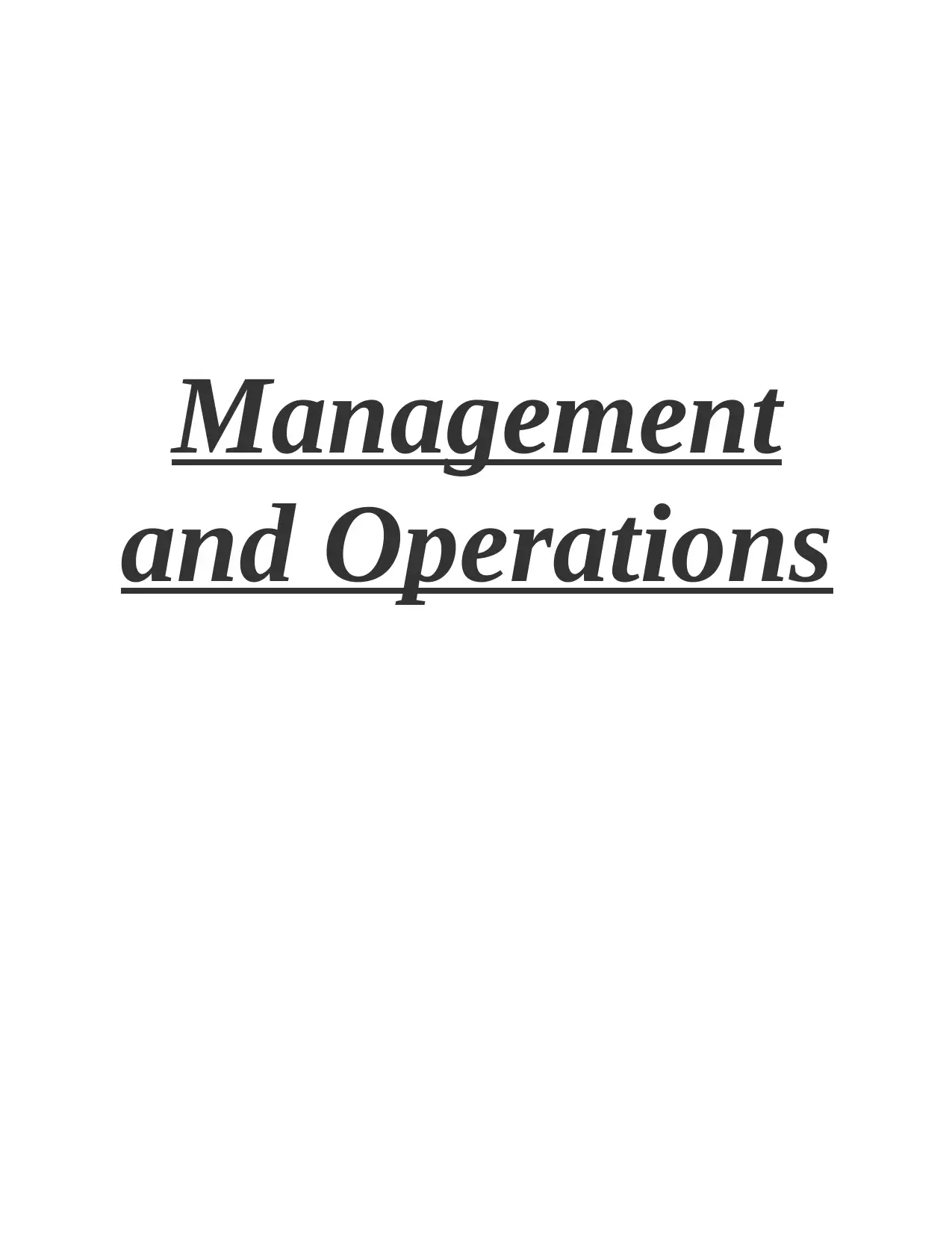
Management
and Operations
and Operations
Paraphrase This Document
Need a fresh take? Get an instant paraphrase of this document with our AI Paraphraser

Table of Contents
INTRODUCTION...........................................................................................................................3
MAIN BODY .................................................................................................................................4
P1 Comparison between roles and characteristics of a leader and a manager ......................4
M1 Difference between role of leader and function of manager by application of range of
theories...................................................................................................................................7
TASK 2............................................................................................................................................7
P2 Role of leader and function of a manager in various business situations ........................7
P3 Application of different leadership approaches including situational leadership,
contingency leadership and systems leadership ...................................................................9
M2 Strengths and weaknesses to different to different approaches to situations within work
environment .........................................................................................................................10
D1 Critical analysis and evaluation of various leadership theories .....................................13
TASK 3..........................................................................................................................................14
P4 Explanation of primary approaches to operations management with the role of leaders and
managers ..............................................................................................................................14
M3 Evaluation of role of leaders and managers to enhance operations management efficiency
to successfully meet bushiness objectives ..........................................................................17
TASK 4..........................................................................................................................................18
P6 Factors within the business environment which effect operations management and decision
making by leaders and managers..........................................................................................18
M4 Analysis of impact of different factors on community and corporate environment .....19
D2 Critical evaluation of application of operations management and factors which impact
wider community..................................................................................................................19
CONCLUSION ............................................................................................................................20
REFRENCES ................................................................................................................................21
INTRODUCTION...........................................................................................................................3
MAIN BODY .................................................................................................................................4
P1 Comparison between roles and characteristics of a leader and a manager ......................4
M1 Difference between role of leader and function of manager by application of range of
theories...................................................................................................................................7
TASK 2............................................................................................................................................7
P2 Role of leader and function of a manager in various business situations ........................7
P3 Application of different leadership approaches including situational leadership,
contingency leadership and systems leadership ...................................................................9
M2 Strengths and weaknesses to different to different approaches to situations within work
environment .........................................................................................................................10
D1 Critical analysis and evaluation of various leadership theories .....................................13
TASK 3..........................................................................................................................................14
P4 Explanation of primary approaches to operations management with the role of leaders and
managers ..............................................................................................................................14
M3 Evaluation of role of leaders and managers to enhance operations management efficiency
to successfully meet bushiness objectives ..........................................................................17
TASK 4..........................................................................................................................................18
P6 Factors within the business environment which effect operations management and decision
making by leaders and managers..........................................................................................18
M4 Analysis of impact of different factors on community and corporate environment .....19
D2 Critical evaluation of application of operations management and factors which impact
wider community..................................................................................................................19
CONCLUSION ............................................................................................................................20
REFRENCES ................................................................................................................................21
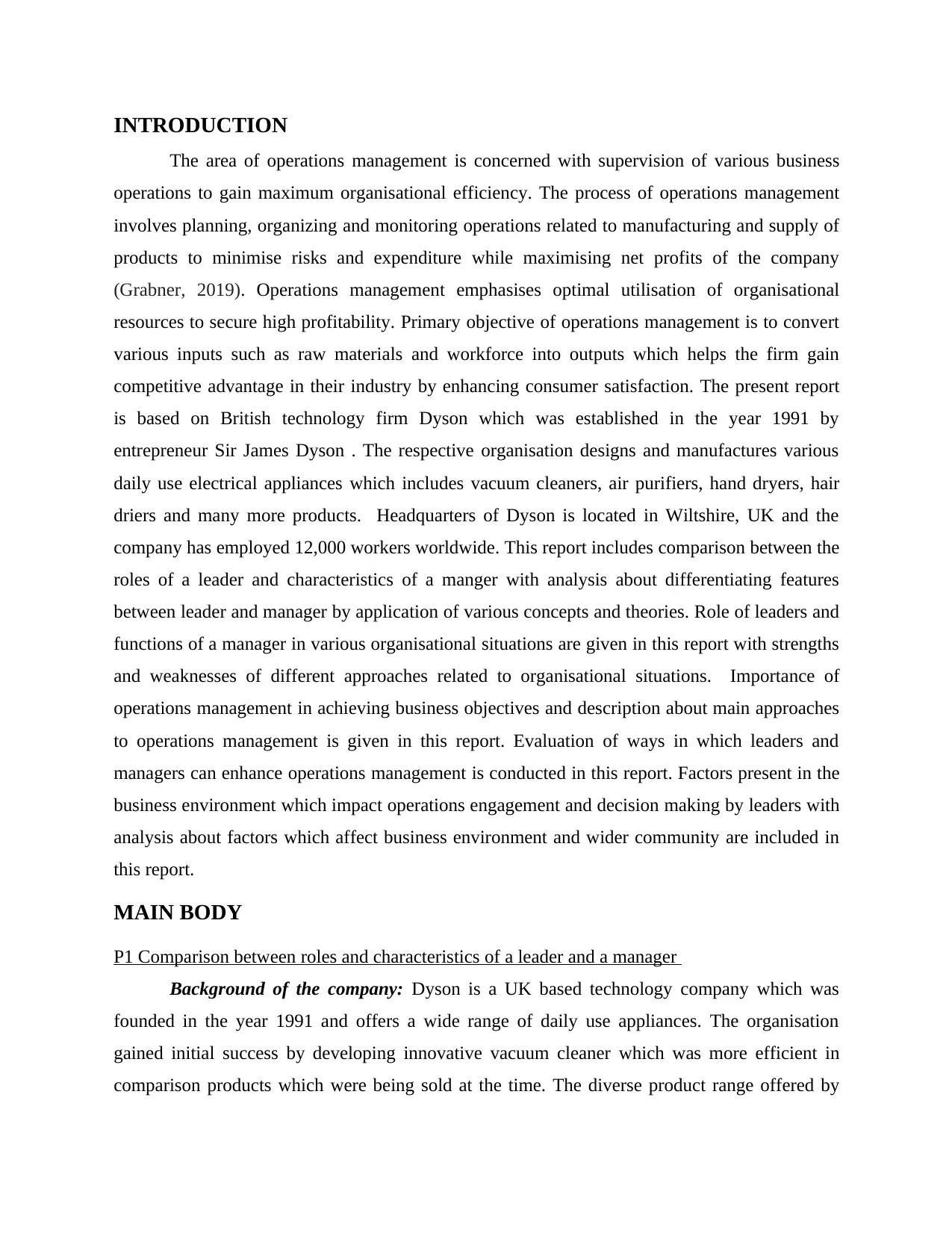
INTRODUCTION
The area of operations management is concerned with supervision of various business
operations to gain maximum organisational efficiency. The process of operations management
involves planning, organizing and monitoring operations related to manufacturing and supply of
products to minimise risks and expenditure while maximising net profits of the company
(Grabner, 2019). Operations management emphasises optimal utilisation of organisational
resources to secure high profitability. Primary objective of operations management is to convert
various inputs such as raw materials and workforce into outputs which helps the firm gain
competitive advantage in their industry by enhancing consumer satisfaction. The present report
is based on British technology firm Dyson which was established in the year 1991 by
entrepreneur Sir James Dyson . The respective organisation designs and manufactures various
daily use electrical appliances which includes vacuum cleaners, air purifiers, hand dryers, hair
driers and many more products. Headquarters of Dyson is located in Wiltshire, UK and the
company has employed 12,000 workers worldwide. This report includes comparison between the
roles of a leader and characteristics of a manger with analysis about differentiating features
between leader and manager by application of various concepts and theories. Role of leaders and
functions of a manager in various organisational situations are given in this report with strengths
and weaknesses of different approaches related to organisational situations. Importance of
operations management in achieving business objectives and description about main approaches
to operations management is given in this report. Evaluation of ways in which leaders and
managers can enhance operations management is conducted in this report. Factors present in the
business environment which impact operations engagement and decision making by leaders with
analysis about factors which affect business environment and wider community are included in
this report.
MAIN BODY
P1 Comparison between roles and characteristics of a leader and a manager
Background of the company: Dyson is a UK based technology company which was
founded in the year 1991 and offers a wide range of daily use appliances. The organisation
gained initial success by developing innovative vacuum cleaner which was more efficient in
comparison products which were being sold at the time. The diverse product range offered by
The area of operations management is concerned with supervision of various business
operations to gain maximum organisational efficiency. The process of operations management
involves planning, organizing and monitoring operations related to manufacturing and supply of
products to minimise risks and expenditure while maximising net profits of the company
(Grabner, 2019). Operations management emphasises optimal utilisation of organisational
resources to secure high profitability. Primary objective of operations management is to convert
various inputs such as raw materials and workforce into outputs which helps the firm gain
competitive advantage in their industry by enhancing consumer satisfaction. The present report
is based on British technology firm Dyson which was established in the year 1991 by
entrepreneur Sir James Dyson . The respective organisation designs and manufactures various
daily use electrical appliances which includes vacuum cleaners, air purifiers, hand dryers, hair
driers and many more products. Headquarters of Dyson is located in Wiltshire, UK and the
company has employed 12,000 workers worldwide. This report includes comparison between the
roles of a leader and characteristics of a manger with analysis about differentiating features
between leader and manager by application of various concepts and theories. Role of leaders and
functions of a manager in various organisational situations are given in this report with strengths
and weaknesses of different approaches related to organisational situations. Importance of
operations management in achieving business objectives and description about main approaches
to operations management is given in this report. Evaluation of ways in which leaders and
managers can enhance operations management is conducted in this report. Factors present in the
business environment which impact operations engagement and decision making by leaders with
analysis about factors which affect business environment and wider community are included in
this report.
MAIN BODY
P1 Comparison between roles and characteristics of a leader and a manager
Background of the company: Dyson is a UK based technology company which was
founded in the year 1991 and offers a wide range of daily use appliances. The organisation
gained initial success by developing innovative vacuum cleaner which was more efficient in
comparison products which were being sold at the time. The diverse product range offered by
⊘ This is a preview!⊘
Do you want full access?
Subscribe today to unlock all pages.

Trusted by 1+ million students worldwide
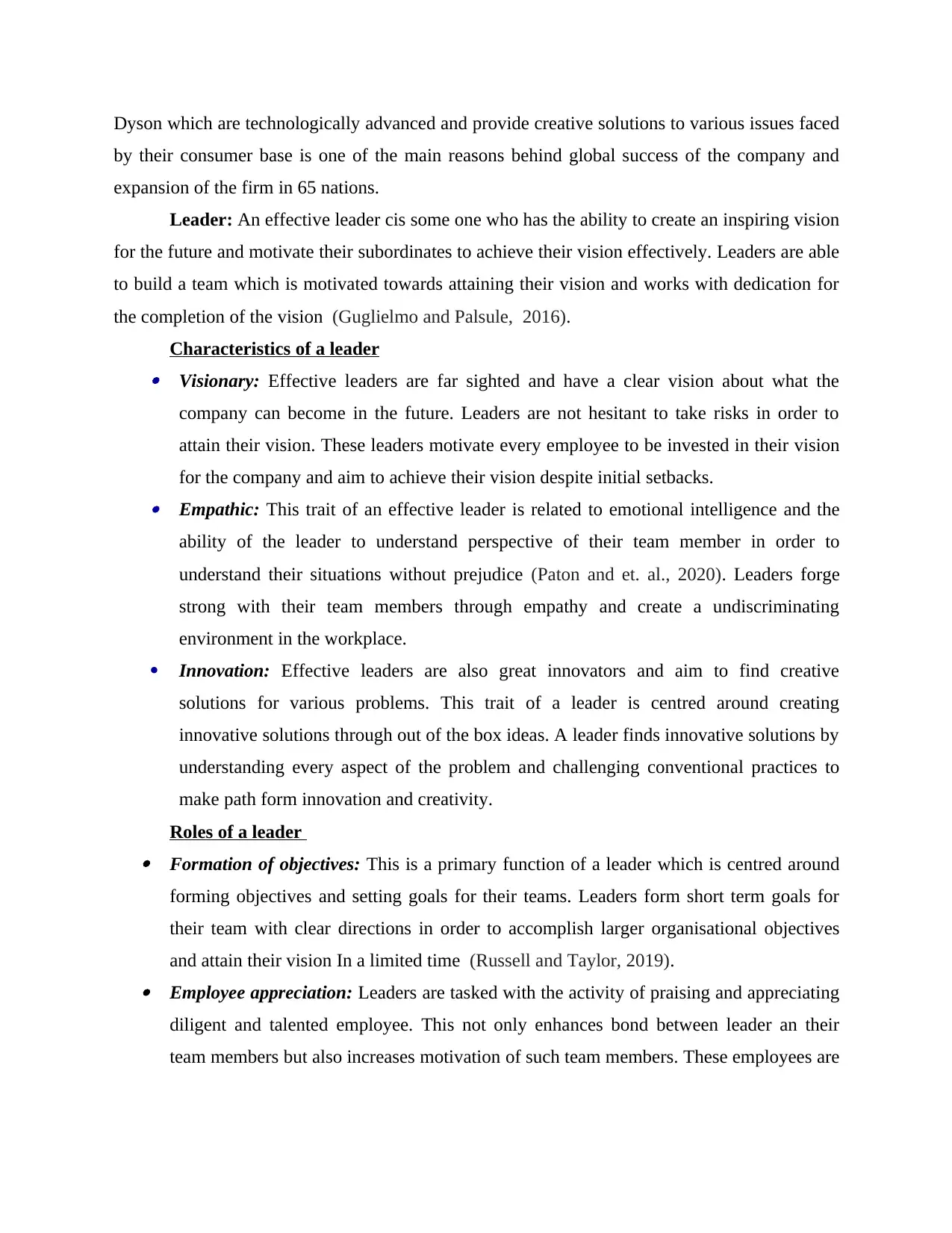
Dyson which are technologically advanced and provide creative solutions to various issues faced
by their consumer base is one of the main reasons behind global success of the company and
expansion of the firm in 65 nations.
Leader: An effective leader cis some one who has the ability to create an inspiring vision
for the future and motivate their subordinates to achieve their vision effectively. Leaders are able
to build a team which is motivated towards attaining their vision and works with dedication for
the completion of the vision (Guglielmo and Palsule, 2016).
Characteristics of a leader Visionary: Effective leaders are far sighted and have a clear vision about what the
company can become in the future. Leaders are not hesitant to take risks in order to
attain their vision. These leaders motivate every employee to be invested in their vision
for the company and aim to achieve their vision despite initial setbacks. Empathic: This trait of an effective leader is related to emotional intelligence and the
ability of the leader to understand perspective of their team member in order to
understand their situations without prejudice (Paton and et. al., 2020). Leaders forge
strong with their team members through empathy and create a undiscriminating
environment in the workplace.
Innovation: Effective leaders are also great innovators and aim to find creative
solutions for various problems. This trait of a leader is centred around creating
innovative solutions through out of the box ideas. A leader finds innovative solutions by
understanding every aspect of the problem and challenging conventional practices to
make path form innovation and creativity.
Roles of a leader Formation of objectives: This is a primary function of a leader which is centred around
forming objectives and setting goals for their teams. Leaders form short term goals for
their team with clear directions in order to accomplish larger organisational objectives
and attain their vision In a limited time (Russell and Taylor, 2019). Employee appreciation: Leaders are tasked with the activity of praising and appreciating
diligent and talented employee. This not only enhances bond between leader an their
team members but also increases motivation of such team members. These employees are
by their consumer base is one of the main reasons behind global success of the company and
expansion of the firm in 65 nations.
Leader: An effective leader cis some one who has the ability to create an inspiring vision
for the future and motivate their subordinates to achieve their vision effectively. Leaders are able
to build a team which is motivated towards attaining their vision and works with dedication for
the completion of the vision (Guglielmo and Palsule, 2016).
Characteristics of a leader Visionary: Effective leaders are far sighted and have a clear vision about what the
company can become in the future. Leaders are not hesitant to take risks in order to
attain their vision. These leaders motivate every employee to be invested in their vision
for the company and aim to achieve their vision despite initial setbacks. Empathic: This trait of an effective leader is related to emotional intelligence and the
ability of the leader to understand perspective of their team member in order to
understand their situations without prejudice (Paton and et. al., 2020). Leaders forge
strong with their team members through empathy and create a undiscriminating
environment in the workplace.
Innovation: Effective leaders are also great innovators and aim to find creative
solutions for various problems. This trait of a leader is centred around creating
innovative solutions through out of the box ideas. A leader finds innovative solutions by
understanding every aspect of the problem and challenging conventional practices to
make path form innovation and creativity.
Roles of a leader Formation of objectives: This is a primary function of a leader which is centred around
forming objectives and setting goals for their teams. Leaders form short term goals for
their team with clear directions in order to accomplish larger organisational objectives
and attain their vision In a limited time (Russell and Taylor, 2019). Employee appreciation: Leaders are tasked with the activity of praising and appreciating
diligent and talented employee. This not only enhances bond between leader an their
team members but also increases motivation of such team members. These employees are
Paraphrase This Document
Need a fresh take? Get an instant paraphrase of this document with our AI Paraphraser
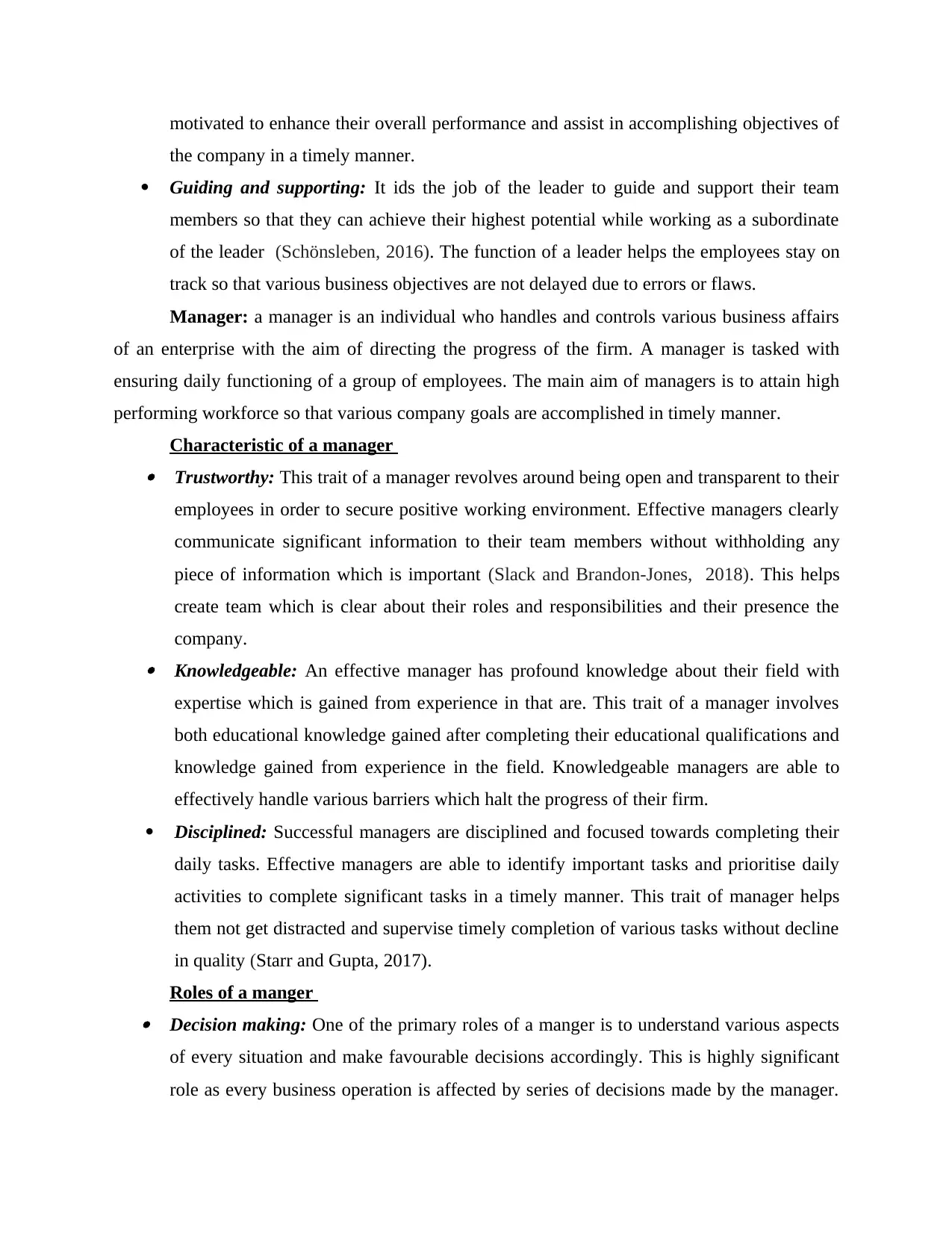
motivated to enhance their overall performance and assist in accomplishing objectives of
the company in a timely manner.
Guiding and supporting: It ids the job of the leader to guide and support their team
members so that they can achieve their highest potential while working as a subordinate
of the leader (Schönsleben, 2016). The function of a leader helps the employees stay on
track so that various business objectives are not delayed due to errors or flaws.
Manager: a manager is an individual who handles and controls various business affairs
of an enterprise with the aim of directing the progress of the firm. A manager is tasked with
ensuring daily functioning of a group of employees. The main aim of managers is to attain high
performing workforce so that various company goals are accomplished in timely manner.
Characteristic of a manager Trustworthy: This trait of a manager revolves around being open and transparent to their
employees in order to secure positive working environment. Effective managers clearly
communicate significant information to their team members without withholding any
piece of information which is important (Slack and Brandon-Jones, 2018). This helps
create team which is clear about their roles and responsibilities and their presence the
company. Knowledgeable: An effective manager has profound knowledge about their field with
expertise which is gained from experience in that are. This trait of a manager involves
both educational knowledge gained after completing their educational qualifications and
knowledge gained from experience in the field. Knowledgeable managers are able to
effectively handle various barriers which halt the progress of their firm.
Disciplined: Successful managers are disciplined and focused towards completing their
daily tasks. Effective managers are able to identify important tasks and prioritise daily
activities to complete significant tasks in a timely manner. This trait of manager helps
them not get distracted and supervise timely completion of various tasks without decline
in quality (Starr and Gupta, 2017).
Roles of a manger Decision making: One of the primary roles of a manger is to understand various aspects
of every situation and make favourable decisions accordingly. This is highly significant
role as every business operation is affected by series of decisions made by the manager.
the company in a timely manner.
Guiding and supporting: It ids the job of the leader to guide and support their team
members so that they can achieve their highest potential while working as a subordinate
of the leader (Schönsleben, 2016). The function of a leader helps the employees stay on
track so that various business objectives are not delayed due to errors or flaws.
Manager: a manager is an individual who handles and controls various business affairs
of an enterprise with the aim of directing the progress of the firm. A manager is tasked with
ensuring daily functioning of a group of employees. The main aim of managers is to attain high
performing workforce so that various company goals are accomplished in timely manner.
Characteristic of a manager Trustworthy: This trait of a manager revolves around being open and transparent to their
employees in order to secure positive working environment. Effective managers clearly
communicate significant information to their team members without withholding any
piece of information which is important (Slack and Brandon-Jones, 2018). This helps
create team which is clear about their roles and responsibilities and their presence the
company. Knowledgeable: An effective manager has profound knowledge about their field with
expertise which is gained from experience in that are. This trait of a manager involves
both educational knowledge gained after completing their educational qualifications and
knowledge gained from experience in the field. Knowledgeable managers are able to
effectively handle various barriers which halt the progress of their firm.
Disciplined: Successful managers are disciplined and focused towards completing their
daily tasks. Effective managers are able to identify important tasks and prioritise daily
activities to complete significant tasks in a timely manner. This trait of manager helps
them not get distracted and supervise timely completion of various tasks without decline
in quality (Starr and Gupta, 2017).
Roles of a manger Decision making: One of the primary roles of a manger is to understand various aspects
of every situation and make favourable decisions accordingly. This is highly significant
role as every business operation is affected by series of decisions made by the manager.

This function of manager involves identification and interpretation of significant
information to make proper decisions. In order to make unbiased decisions which are
favourable for the company effective managers need to look at every element with
objectivity while only considering the suitable path which is advantageous for the firm. Supervision: This role of the manager revolves around supervising various team
members to ensure that every task is being completed with accurately and systematically.
Manager needs to ensure that every operation is being conducted by following the right
procedure so that the firm is quality of output is not decreased (Venkataraman and
Pinto, 2016). Apart from it is the function of a manager to continuously track the
progress of the employees to identify core competencies and areas which require
improvement. Supervision of employees is important as the manager constructs various
employee benefit policies such as reward policies and training sessions on the basis of
information gathered through strict supervision of employees.
Organizing: This role of the manager is concerned with organizing resources of their
team to achieve maximum efficiency. In order to organize various resources such as
labour and raw materials effectively the manager identifies resource requirement and
allots them accordingly. Apart from this assigning work according to the skills and
capabilities of their workforce to achieve optimal utilisation of workforce is part of this
role. Managers identify skills of each employee and give them tasks which matches their
existing abilities to ensure smooth functioning of the firm.
M1 Difference between role of leader and function of manager by application of range of
theories
Leaders and managers at every organisation are tasked with completing different
responsibilities. Leaders and manager sat Dyson conduct different activities for growth of the
company.
Behavioural leadership theory: This theory of leadership focuses on behaviour of
leader instead of their attributes as the key to effective leadership. Leaders at Dyson utilise this
theory of leadership to build and sustain strong bonds with the employees to motivate them into
reaching their highest potential which helps the company complete various tasks in a timely
manner (Grabner, 2019).
information to make proper decisions. In order to make unbiased decisions which are
favourable for the company effective managers need to look at every element with
objectivity while only considering the suitable path which is advantageous for the firm. Supervision: This role of the manager revolves around supervising various team
members to ensure that every task is being completed with accurately and systematically.
Manager needs to ensure that every operation is being conducted by following the right
procedure so that the firm is quality of output is not decreased (Venkataraman and
Pinto, 2016). Apart from it is the function of a manager to continuously track the
progress of the employees to identify core competencies and areas which require
improvement. Supervision of employees is important as the manager constructs various
employee benefit policies such as reward policies and training sessions on the basis of
information gathered through strict supervision of employees.
Organizing: This role of the manager is concerned with organizing resources of their
team to achieve maximum efficiency. In order to organize various resources such as
labour and raw materials effectively the manager identifies resource requirement and
allots them accordingly. Apart from this assigning work according to the skills and
capabilities of their workforce to achieve optimal utilisation of workforce is part of this
role. Managers identify skills of each employee and give them tasks which matches their
existing abilities to ensure smooth functioning of the firm.
M1 Difference between role of leader and function of manager by application of range of
theories
Leaders and managers at every organisation are tasked with completing different
responsibilities. Leaders and manager sat Dyson conduct different activities for growth of the
company.
Behavioural leadership theory: This theory of leadership focuses on behaviour of
leader instead of their attributes as the key to effective leadership. Leaders at Dyson utilise this
theory of leadership to build and sustain strong bonds with the employees to motivate them into
reaching their highest potential which helps the company complete various tasks in a timely
manner (Grabner, 2019).
⊘ This is a preview!⊘
Do you want full access?
Subscribe today to unlock all pages.

Trusted by 1+ million students worldwide

Transformational theory of leadership: This theory emphasises idealised influence,
inspirational motivation, intellectual simulation and individual consideration. Leaders at Dyson
utilise this theory to inspire their employees by developing a vision for the employees which
helps the company attain success.
Systems management theory: This theory of management states that business
organisation consists of various components which need to work together for smooth functioning
of the firm. The managers at Dyson utilise this theory to by understanding interrelation between
various parts of the company and formation of effective systems which ensure collaboration
between various components for growth of the company (Guglielmo and Palsule, 2016).
Contingency management theory: This theory states that effective management is
contingent on usage of management behaviour and particular conditions. Managers at Dyson
utilise this theory in order handle various business conditions effectively.
TASK 2
P2 Role of leader and function of a manager in various business situations
One significant task of managers and leaders is to handle various business in a way
which eliminates obstacles to growth and assists in successful completion of various business
endeavours. The firm is able to avoid huge losses due to the role leaders play and functions
conducted by managers during various business situations. Managers and leaders at Dyson
conduct different functions according to different business situations. Role of a leader and
functions of a manager during various organisational situations in context of British technology
company Dyson is provided below:
Conflict management
This situation occurs at a firm due to miscommunication or lack of accountability.
Conflicts between various employees result in delay of daily business operations and construct a
negative working environment which decrease overall productivity of the company (Paton and
et. al., 2020). In context of Dyson conflict management is essential as unresolved conflicts
impact quality of various products and services offered by the firm which negatively impacts the
sales of the company.
Role of a leader: The role of leader at Dyson during situation of conflict is to resolve
conflicts through self-awareness, communication, emotional intelligence and appreciation for
inspirational motivation, intellectual simulation and individual consideration. Leaders at Dyson
utilise this theory to inspire their employees by developing a vision for the employees which
helps the company attain success.
Systems management theory: This theory of management states that business
organisation consists of various components which need to work together for smooth functioning
of the firm. The managers at Dyson utilise this theory to by understanding interrelation between
various parts of the company and formation of effective systems which ensure collaboration
between various components for growth of the company (Guglielmo and Palsule, 2016).
Contingency management theory: This theory states that effective management is
contingent on usage of management behaviour and particular conditions. Managers at Dyson
utilise this theory in order handle various business conditions effectively.
TASK 2
P2 Role of leader and function of a manager in various business situations
One significant task of managers and leaders is to handle various business in a way
which eliminates obstacles to growth and assists in successful completion of various business
endeavours. The firm is able to avoid huge losses due to the role leaders play and functions
conducted by managers during various business situations. Managers and leaders at Dyson
conduct different functions according to different business situations. Role of a leader and
functions of a manager during various organisational situations in context of British technology
company Dyson is provided below:
Conflict management
This situation occurs at a firm due to miscommunication or lack of accountability.
Conflicts between various employees result in delay of daily business operations and construct a
negative working environment which decrease overall productivity of the company (Paton and
et. al., 2020). In context of Dyson conflict management is essential as unresolved conflicts
impact quality of various products and services offered by the firm which negatively impacts the
sales of the company.
Role of a leader: The role of leader at Dyson during situation of conflict is to resolve
conflicts through self-awareness, communication, emotional intelligence and appreciation for
Paraphrase This Document
Need a fresh take? Get an instant paraphrase of this document with our AI Paraphraser
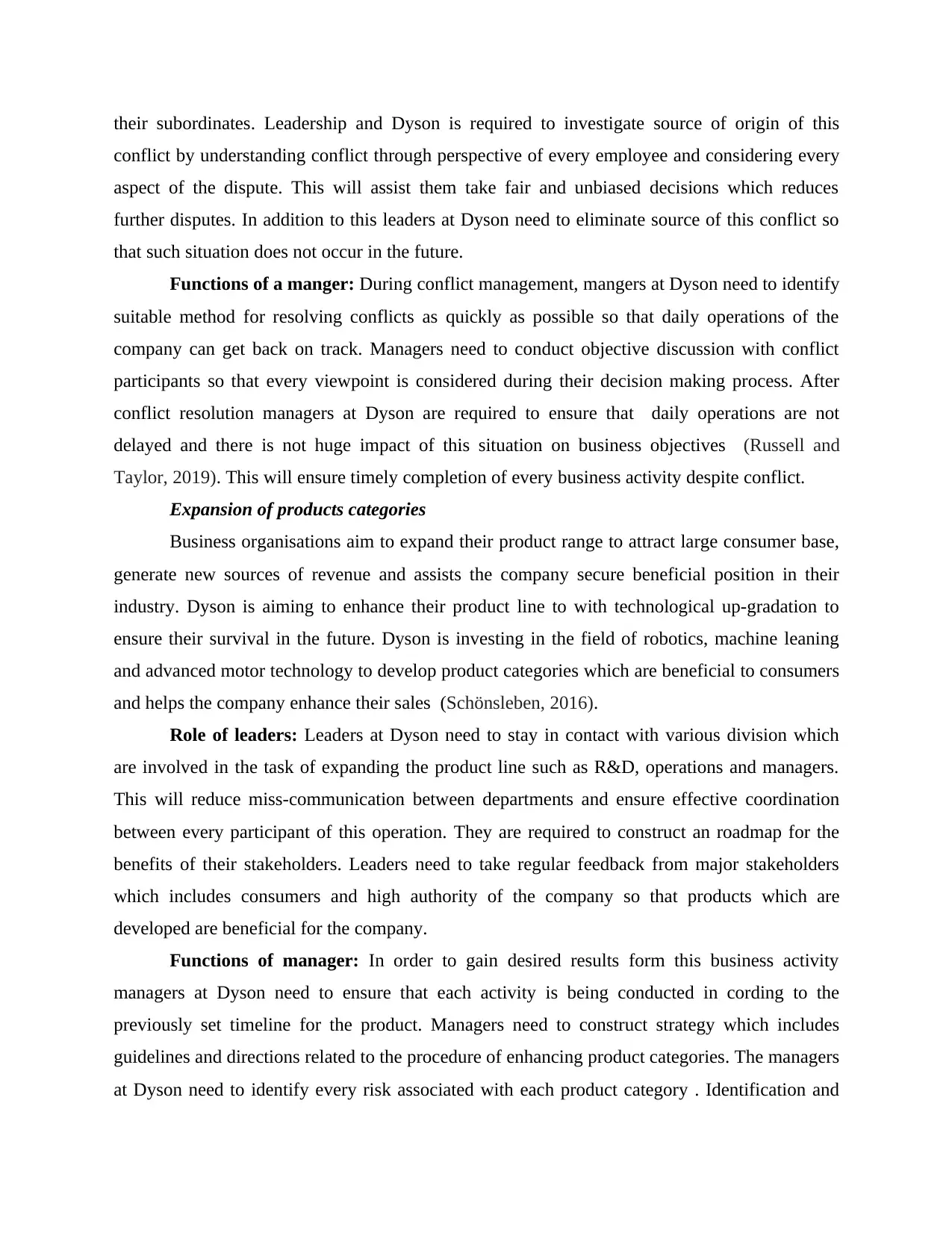
their subordinates. Leadership and Dyson is required to investigate source of origin of this
conflict by understanding conflict through perspective of every employee and considering every
aspect of the dispute. This will assist them take fair and unbiased decisions which reduces
further disputes. In addition to this leaders at Dyson need to eliminate source of this conflict so
that such situation does not occur in the future.
Functions of a manger: During conflict management, mangers at Dyson need to identify
suitable method for resolving conflicts as quickly as possible so that daily operations of the
company can get back on track. Managers need to conduct objective discussion with conflict
participants so that every viewpoint is considered during their decision making process. After
conflict resolution managers at Dyson are required to ensure that daily operations are not
delayed and there is not huge impact of this situation on business objectives (Russell and
Taylor, 2019). This will ensure timely completion of every business activity despite conflict.
Expansion of products categories
Business organisations aim to expand their product range to attract large consumer base,
generate new sources of revenue and assists the company secure beneficial position in their
industry. Dyson is aiming to enhance their product line to with technological up-gradation to
ensure their survival in the future. Dyson is investing in the field of robotics, machine leaning
and advanced motor technology to develop product categories which are beneficial to consumers
and helps the company enhance their sales (Schönsleben, 2016).
Role of leaders: Leaders at Dyson need to stay in contact with various division which
are involved in the task of expanding the product line such as R&D, operations and managers.
This will reduce miss-communication between departments and ensure effective coordination
between every participant of this operation. They are required to construct an roadmap for the
benefits of their stakeholders. Leaders need to take regular feedback from major stakeholders
which includes consumers and high authority of the company so that products which are
developed are beneficial for the company.
Functions of manager: In order to gain desired results form this business activity
managers at Dyson need to ensure that each activity is being conducted in cording to the
previously set timeline for the product. Managers need to construct strategy which includes
guidelines and directions related to the procedure of enhancing product categories. The managers
at Dyson need to identify every risk associated with each product category . Identification and
conflict by understanding conflict through perspective of every employee and considering every
aspect of the dispute. This will assist them take fair and unbiased decisions which reduces
further disputes. In addition to this leaders at Dyson need to eliminate source of this conflict so
that such situation does not occur in the future.
Functions of a manger: During conflict management, mangers at Dyson need to identify
suitable method for resolving conflicts as quickly as possible so that daily operations of the
company can get back on track. Managers need to conduct objective discussion with conflict
participants so that every viewpoint is considered during their decision making process. After
conflict resolution managers at Dyson are required to ensure that daily operations are not
delayed and there is not huge impact of this situation on business objectives (Russell and
Taylor, 2019). This will ensure timely completion of every business activity despite conflict.
Expansion of products categories
Business organisations aim to expand their product range to attract large consumer base,
generate new sources of revenue and assists the company secure beneficial position in their
industry. Dyson is aiming to enhance their product line to with technological up-gradation to
ensure their survival in the future. Dyson is investing in the field of robotics, machine leaning
and advanced motor technology to develop product categories which are beneficial to consumers
and helps the company enhance their sales (Schönsleben, 2016).
Role of leaders: Leaders at Dyson need to stay in contact with various division which
are involved in the task of expanding the product line such as R&D, operations and managers.
This will reduce miss-communication between departments and ensure effective coordination
between every participant of this operation. They are required to construct an roadmap for the
benefits of their stakeholders. Leaders need to take regular feedback from major stakeholders
which includes consumers and high authority of the company so that products which are
developed are beneficial for the company.
Functions of manager: In order to gain desired results form this business activity
managers at Dyson need to ensure that each activity is being conducted in cording to the
previously set timeline for the product. Managers need to construct strategy which includes
guidelines and directions related to the procedure of enhancing product categories. The managers
at Dyson need to identify every risk associated with each product category . Identification and
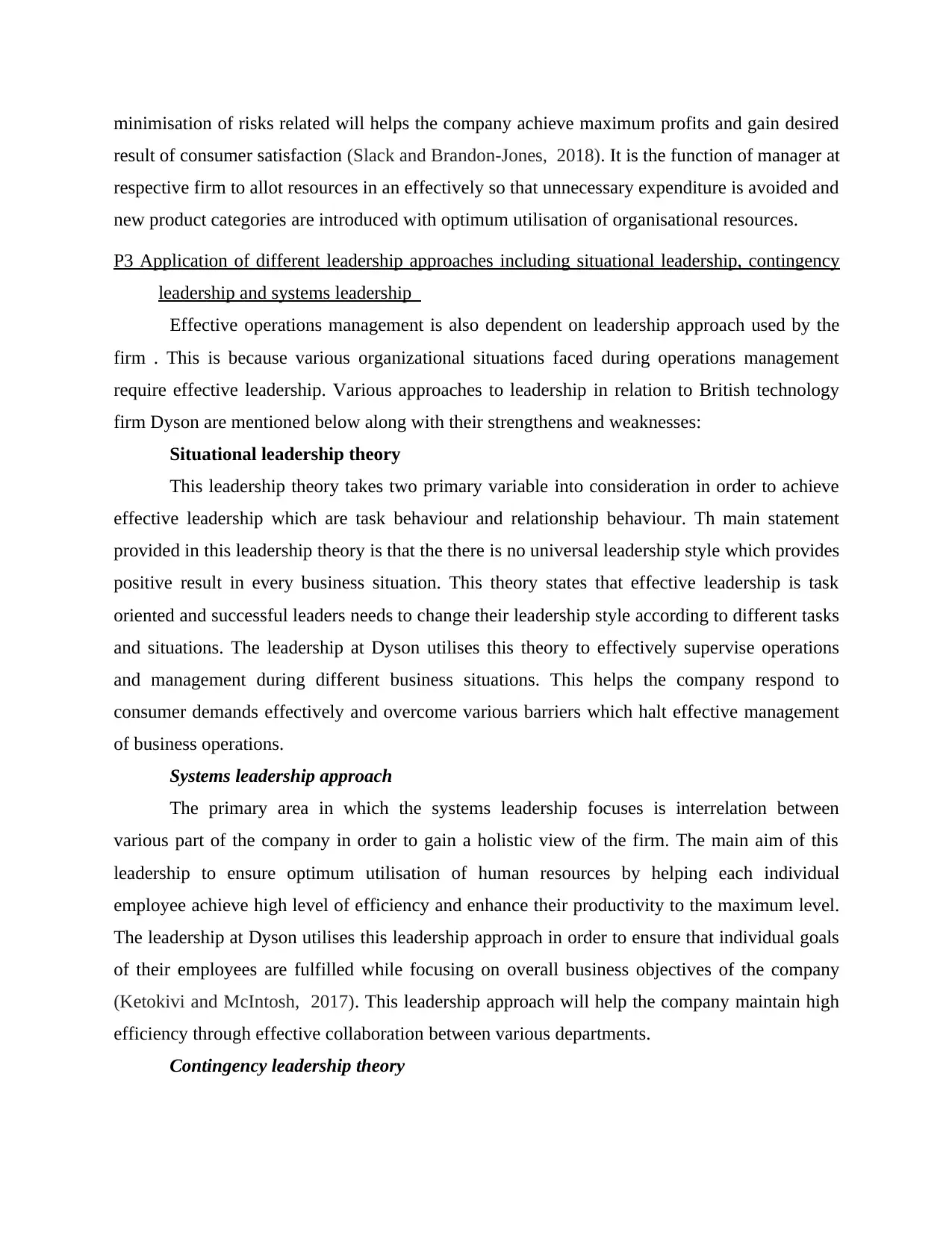
minimisation of risks related will helps the company achieve maximum profits and gain desired
result of consumer satisfaction (Slack and Brandon-Jones, 2018). It is the function of manager at
respective firm to allot resources in an effectively so that unnecessary expenditure is avoided and
new product categories are introduced with optimum utilisation of organisational resources.
P3 Application of different leadership approaches including situational leadership, contingency
leadership and systems leadership
Effective operations management is also dependent on leadership approach used by the
firm . This is because various organizational situations faced during operations management
require effective leadership. Various approaches to leadership in relation to British technology
firm Dyson are mentioned below along with their strengthens and weaknesses:
Situational leadership theory
This leadership theory takes two primary variable into consideration in order to achieve
effective leadership which are task behaviour and relationship behaviour. Th main statement
provided in this leadership theory is that the there is no universal leadership style which provides
positive result in every business situation. This theory states that effective leadership is task
oriented and successful leaders needs to change their leadership style according to different tasks
and situations. The leadership at Dyson utilises this theory to effectively supervise operations
and management during different business situations. This helps the company respond to
consumer demands effectively and overcome various barriers which halt effective management
of business operations.
Systems leadership approach
The primary area in which the systems leadership focuses is interrelation between
various part of the company in order to gain a holistic view of the firm. The main aim of this
leadership to ensure optimum utilisation of human resources by helping each individual
employee achieve high level of efficiency and enhance their productivity to the maximum level.
The leadership at Dyson utilises this leadership approach in order to ensure that individual goals
of their employees are fulfilled while focusing on overall business objectives of the company
(Ketokivi and McIntosh, 2017). This leadership approach will help the company maintain high
efficiency through effective collaboration between various departments.
Contingency leadership theory
result of consumer satisfaction (Slack and Brandon-Jones, 2018). It is the function of manager at
respective firm to allot resources in an effectively so that unnecessary expenditure is avoided and
new product categories are introduced with optimum utilisation of organisational resources.
P3 Application of different leadership approaches including situational leadership, contingency
leadership and systems leadership
Effective operations management is also dependent on leadership approach used by the
firm . This is because various organizational situations faced during operations management
require effective leadership. Various approaches to leadership in relation to British technology
firm Dyson are mentioned below along with their strengthens and weaknesses:
Situational leadership theory
This leadership theory takes two primary variable into consideration in order to achieve
effective leadership which are task behaviour and relationship behaviour. Th main statement
provided in this leadership theory is that the there is no universal leadership style which provides
positive result in every business situation. This theory states that effective leadership is task
oriented and successful leaders needs to change their leadership style according to different tasks
and situations. The leadership at Dyson utilises this theory to effectively supervise operations
and management during different business situations. This helps the company respond to
consumer demands effectively and overcome various barriers which halt effective management
of business operations.
Systems leadership approach
The primary area in which the systems leadership focuses is interrelation between
various part of the company in order to gain a holistic view of the firm. The main aim of this
leadership to ensure optimum utilisation of human resources by helping each individual
employee achieve high level of efficiency and enhance their productivity to the maximum level.
The leadership at Dyson utilises this leadership approach in order to ensure that individual goals
of their employees are fulfilled while focusing on overall business objectives of the company
(Ketokivi and McIntosh, 2017). This leadership approach will help the company maintain high
efficiency through effective collaboration between various departments.
Contingency leadership theory
⊘ This is a preview!⊘
Do you want full access?
Subscribe today to unlock all pages.

Trusted by 1+ million students worldwide

According to this theory of leadership success of a leader depends on situation faced by
the leader and certain factors impact on the success or failure of the leader in graining desired
result. The factors which are considered by this leadership style include personality of the leader,
the operation which is being conducted and the composition of the team which is working under
the leader. The three primary factors which are outlined under this theory and can effect
leadership are leader-employee relations, operation structure and position power. Relation
between leader and employee refers to the level of confidence, loyalty and attraction the
employees feel toward their leader. Structure of operation is dependent on the fact the goal of the
operation, role of every individual employee and path to successful completion of operation is
clear to everyone employee (Chibisov and et. al., 2017). The last factor is related to authority of
the leader over their employees and if the leader is able to effectively delegate task to their
employees. Leaders at Dyson utilises this leadership approach to complete various tasks in
effective manner and remove faults from every business operations by leading employees after
considering each factor affecting the employee.
M2 Strengths and weaknesses to different to different approaches to situations within work
environment
Situational leadership
Strengths:
Simplified application: This leadership theory is simple in comparison to various other
theories of leadership. It can be easily understood by leaders at Dyson and they can apply
this theory to effectively lead their subordinates. This will increase the contribution of
each employee in organisational success and help the company survive in their industry
for a longer time period.
Employee centric: The main emphasis of this style of leadership is on the subordinates
of the leader. The leader needs to closely look at the merits and weaknesses of their
employees under this leadership style which allows the firm to create positive relations
with their employees and gain employees which are devoted towards success of the firm
(Berbegal and et. al., 2017) Dyson will be able to improve the maturity level of their
employees by using this leadership theory enhance effectiveness of various business
activities.
Weaknesses:
the leader and certain factors impact on the success or failure of the leader in graining desired
result. The factors which are considered by this leadership style include personality of the leader,
the operation which is being conducted and the composition of the team which is working under
the leader. The three primary factors which are outlined under this theory and can effect
leadership are leader-employee relations, operation structure and position power. Relation
between leader and employee refers to the level of confidence, loyalty and attraction the
employees feel toward their leader. Structure of operation is dependent on the fact the goal of the
operation, role of every individual employee and path to successful completion of operation is
clear to everyone employee (Chibisov and et. al., 2017). The last factor is related to authority of
the leader over their employees and if the leader is able to effectively delegate task to their
employees. Leaders at Dyson utilises this leadership approach to complete various tasks in
effective manner and remove faults from every business operations by leading employees after
considering each factor affecting the employee.
M2 Strengths and weaknesses to different to different approaches to situations within work
environment
Situational leadership
Strengths:
Simplified application: This leadership theory is simple in comparison to various other
theories of leadership. It can be easily understood by leaders at Dyson and they can apply
this theory to effectively lead their subordinates. This will increase the contribution of
each employee in organisational success and help the company survive in their industry
for a longer time period.
Employee centric: The main emphasis of this style of leadership is on the subordinates
of the leader. The leader needs to closely look at the merits and weaknesses of their
employees under this leadership style which allows the firm to create positive relations
with their employees and gain employees which are devoted towards success of the firm
(Berbegal and et. al., 2017) Dyson will be able to improve the maturity level of their
employees by using this leadership theory enhance effectiveness of various business
activities.
Weaknesses:
Paraphrase This Document
Need a fresh take? Get an instant paraphrase of this document with our AI Paraphraser
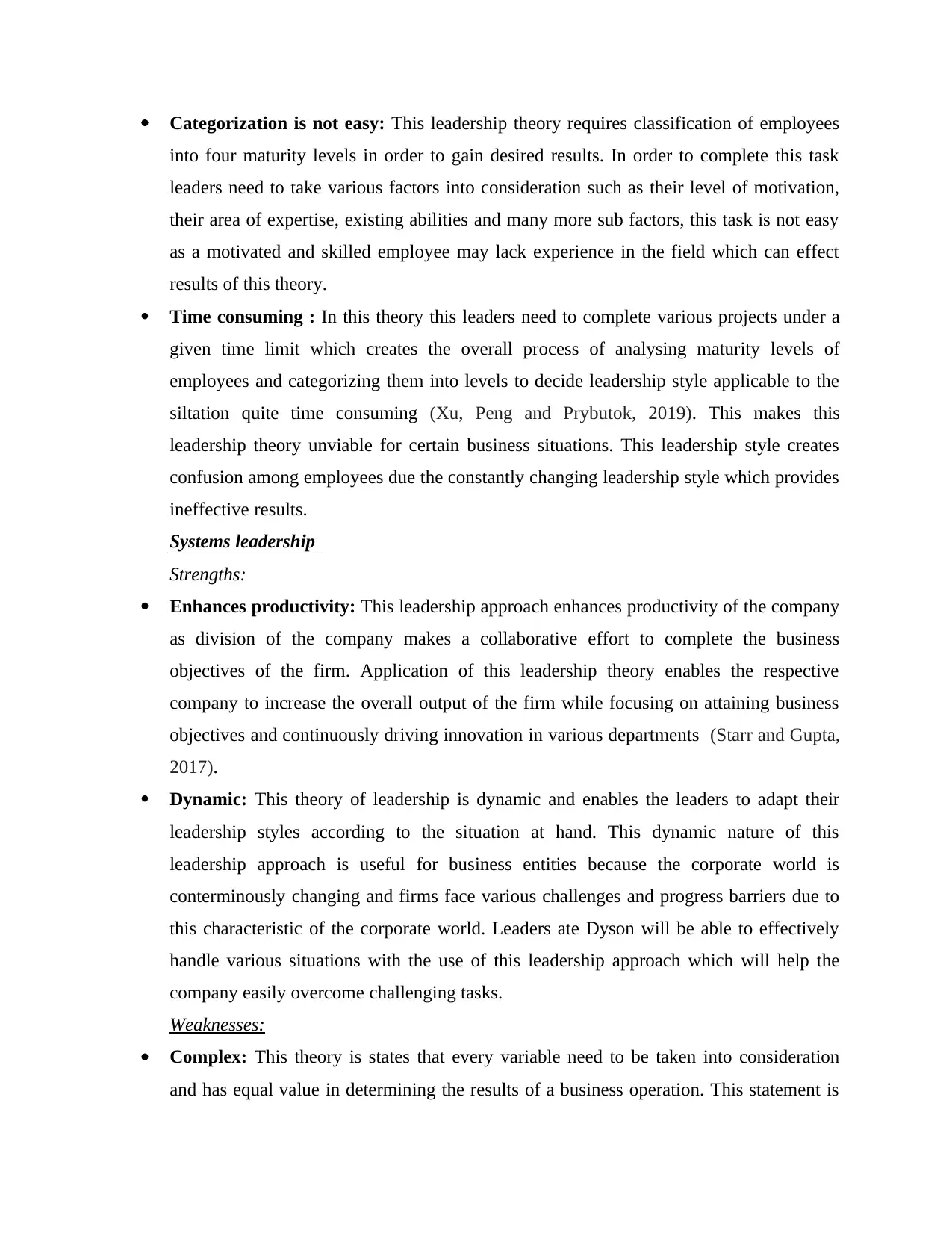
Categorization is not easy: This leadership theory requires classification of employees
into four maturity levels in order to gain desired results. In order to complete this task
leaders need to take various factors into consideration such as their level of motivation,
their area of expertise, existing abilities and many more sub factors, this task is not easy
as a motivated and skilled employee may lack experience in the field which can effect
results of this theory.
Time consuming : In this theory this leaders need to complete various projects under a
given time limit which creates the overall process of analysing maturity levels of
employees and categorizing them into levels to decide leadership style applicable to the
siltation quite time consuming (Xu, Peng and Prybutok, 2019). This makes this
leadership theory unviable for certain business situations. This leadership style creates
confusion among employees due the constantly changing leadership style which provides
ineffective results.
Systems leadership
Strengths:
Enhances productivity: This leadership approach enhances productivity of the company
as division of the company makes a collaborative effort to complete the business
objectives of the firm. Application of this leadership theory enables the respective
company to increase the overall output of the firm while focusing on attaining business
objectives and continuously driving innovation in various departments (Starr and Gupta,
2017).
Dynamic: This theory of leadership is dynamic and enables the leaders to adapt their
leadership styles according to the situation at hand. This dynamic nature of this
leadership approach is useful for business entities because the corporate world is
conterminously changing and firms face various challenges and progress barriers due to
this characteristic of the corporate world. Leaders ate Dyson will be able to effectively
handle various situations with the use of this leadership approach which will help the
company easily overcome challenging tasks.
Weaknesses:
Complex: This theory is states that every variable need to be taken into consideration
and has equal value in determining the results of a business operation. This statement is
into four maturity levels in order to gain desired results. In order to complete this task
leaders need to take various factors into consideration such as their level of motivation,
their area of expertise, existing abilities and many more sub factors, this task is not easy
as a motivated and skilled employee may lack experience in the field which can effect
results of this theory.
Time consuming : In this theory this leaders need to complete various projects under a
given time limit which creates the overall process of analysing maturity levels of
employees and categorizing them into levels to decide leadership style applicable to the
siltation quite time consuming (Xu, Peng and Prybutok, 2019). This makes this
leadership theory unviable for certain business situations. This leadership style creates
confusion among employees due the constantly changing leadership style which provides
ineffective results.
Systems leadership
Strengths:
Enhances productivity: This leadership approach enhances productivity of the company
as division of the company makes a collaborative effort to complete the business
objectives of the firm. Application of this leadership theory enables the respective
company to increase the overall output of the firm while focusing on attaining business
objectives and continuously driving innovation in various departments (Starr and Gupta,
2017).
Dynamic: This theory of leadership is dynamic and enables the leaders to adapt their
leadership styles according to the situation at hand. This dynamic nature of this
leadership approach is useful for business entities because the corporate world is
conterminously changing and firms face various challenges and progress barriers due to
this characteristic of the corporate world. Leaders ate Dyson will be able to effectively
handle various situations with the use of this leadership approach which will help the
company easily overcome challenging tasks.
Weaknesses:
Complex: This theory is states that every variable need to be taken into consideration
and has equal value in determining the results of a business operation. This statement is
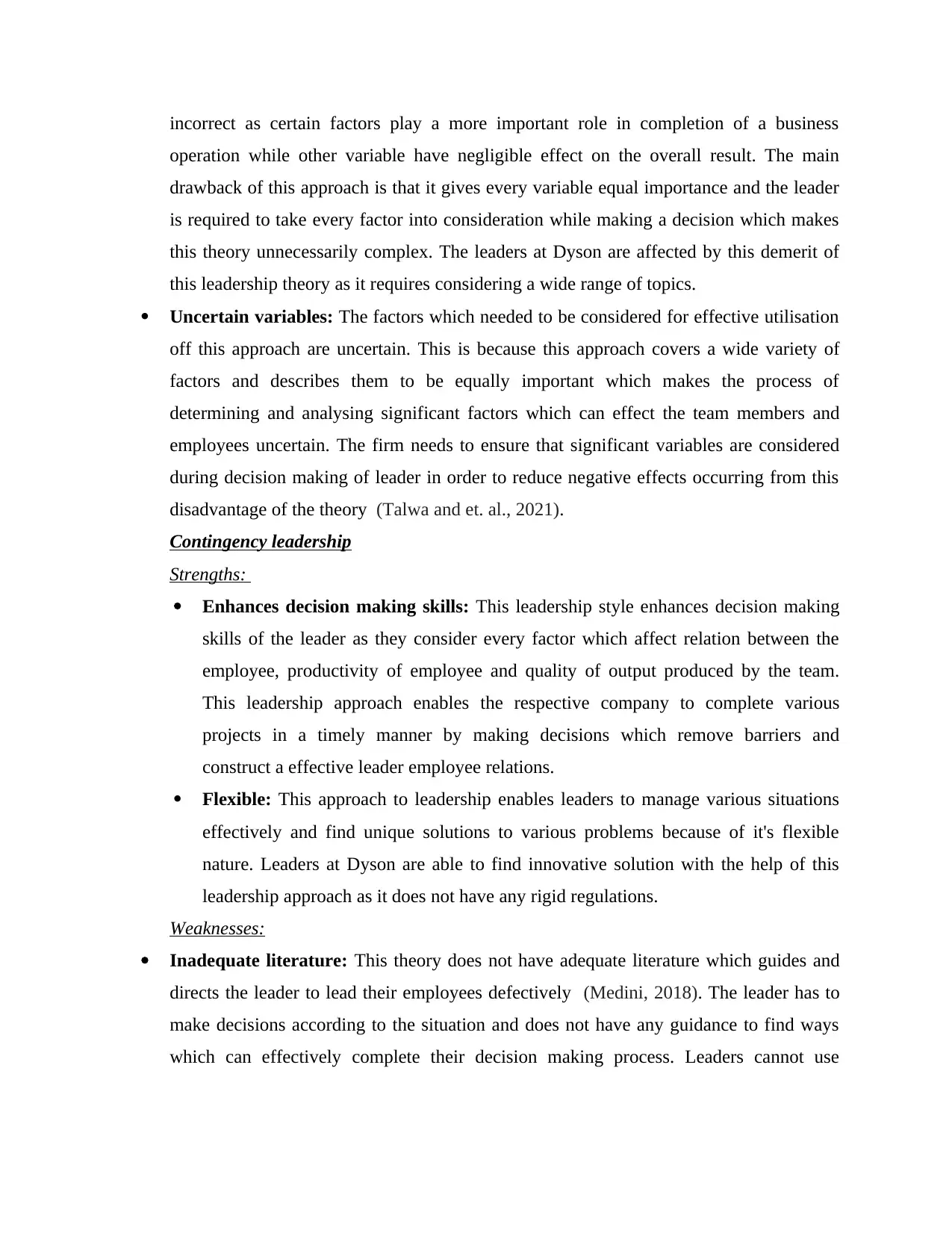
incorrect as certain factors play a more important role in completion of a business
operation while other variable have negligible effect on the overall result. The main
drawback of this approach is that it gives every variable equal importance and the leader
is required to take every factor into consideration while making a decision which makes
this theory unnecessarily complex. The leaders at Dyson are affected by this demerit of
this leadership theory as it requires considering a wide range of topics.
Uncertain variables: The factors which needed to be considered for effective utilisation
off this approach are uncertain. This is because this approach covers a wide variety of
factors and describes them to be equally important which makes the process of
determining and analysing significant factors which can effect the team members and
employees uncertain. The firm needs to ensure that significant variables are considered
during decision making of leader in order to reduce negative effects occurring from this
disadvantage of the theory (Talwa and et. al., 2021).
Contingency leadership
Strengths:
Enhances decision making skills: This leadership style enhances decision making
skills of the leader as they consider every factor which affect relation between the
employee, productivity of employee and quality of output produced by the team.
This leadership approach enables the respective company to complete various
projects in a timely manner by making decisions which remove barriers and
construct a effective leader employee relations.
Flexible: This approach to leadership enables leaders to manage various situations
effectively and find unique solutions to various problems because of it's flexible
nature. Leaders at Dyson are able to find innovative solution with the help of this
leadership approach as it does not have any rigid regulations.
Weaknesses:
Inadequate literature: This theory does not have adequate literature which guides and
directs the leader to lead their employees defectively (Medini, 2018). The leader has to
make decisions according to the situation and does not have any guidance to find ways
which can effectively complete their decision making process. Leaders cannot use
operation while other variable have negligible effect on the overall result. The main
drawback of this approach is that it gives every variable equal importance and the leader
is required to take every factor into consideration while making a decision which makes
this theory unnecessarily complex. The leaders at Dyson are affected by this demerit of
this leadership theory as it requires considering a wide range of topics.
Uncertain variables: The factors which needed to be considered for effective utilisation
off this approach are uncertain. This is because this approach covers a wide variety of
factors and describes them to be equally important which makes the process of
determining and analysing significant factors which can effect the team members and
employees uncertain. The firm needs to ensure that significant variables are considered
during decision making of leader in order to reduce negative effects occurring from this
disadvantage of the theory (Talwa and et. al., 2021).
Contingency leadership
Strengths:
Enhances decision making skills: This leadership style enhances decision making
skills of the leader as they consider every factor which affect relation between the
employee, productivity of employee and quality of output produced by the team.
This leadership approach enables the respective company to complete various
projects in a timely manner by making decisions which remove barriers and
construct a effective leader employee relations.
Flexible: This approach to leadership enables leaders to manage various situations
effectively and find unique solutions to various problems because of it's flexible
nature. Leaders at Dyson are able to find innovative solution with the help of this
leadership approach as it does not have any rigid regulations.
Weaknesses:
Inadequate literature: This theory does not have adequate literature which guides and
directs the leader to lead their employees defectively (Medini, 2018). The leader has to
make decisions according to the situation and does not have any guidance to find ways
which can effectively complete their decision making process. Leaders cannot use
⊘ This is a preview!⊘
Do you want full access?
Subscribe today to unlock all pages.

Trusted by 1+ million students worldwide
1 out of 22
Related Documents
Your All-in-One AI-Powered Toolkit for Academic Success.
+13062052269
info@desklib.com
Available 24*7 on WhatsApp / Email
![[object Object]](/_next/static/media/star-bottom.7253800d.svg)
Unlock your academic potential
Copyright © 2020–2025 A2Z Services. All Rights Reserved. Developed and managed by ZUCOL.





